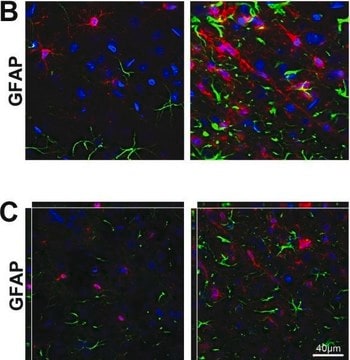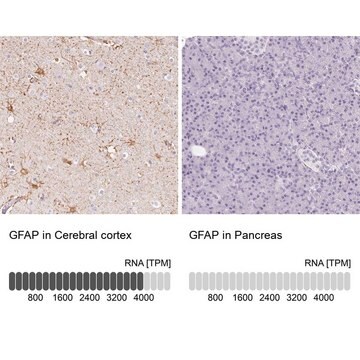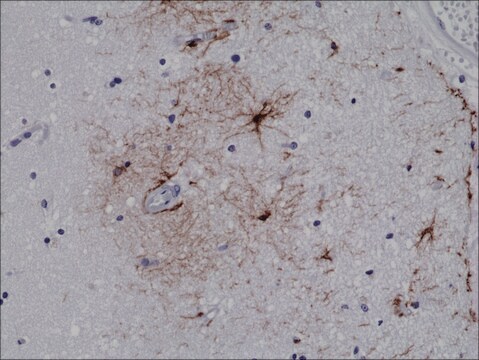AB5541
Anti-Glial Fibrillary Acidic Protein Antibody
CHEMICON®, chicken polyclonal
Synonym(s):
GFAP
About This Item
Recommended Products
product name
Anti-Glial Fibrillary Acidic Protein Antibody, Chemicon®, from chicken
biological source
chicken
Quality Level
antibody form
affinity isolated antibody
antibody product type
primary antibodies
clone
polyclonal
purified by
affinity chromatography
species reactivity
human, mouse, rat, bovine, pig
manufacturer/tradename
Chemicon®
technique(s)
immunocytochemistry: suitable
immunohistochemistry (formalin-fixed, paraffin-embedded sections): suitable
western blot: suitable
NCBI accession no.
UniProt accession no.
shipped in
dry ice
target post-translational modification
unmodified
Gene Information
human ... GFAP(2670)
General description
Specificity
Immunogen
Application
Representative images from a previous lot. Pictures of Optimal Staining With Citrate Buffer Epitope Retrieval: Human Brain.
Immunocytochemistry:
1:200-1:1,000 on cells in tissue culture fixed for one minute in 3.7% formalin and one minute in -20°C methanol.
Western blot:
1:100-1:500 using ECL. Recognizes a band of 55 kDa. May also react with a band of 50 kDa.
Immunohistochemistry:
1:100-1:500 on frozen tissue sections. Suggested fixative is 4% paraformaldehyde.
Optimal working dilutions must be determined by the end user.
STAINING PATTERN:
The antibody stains sharply defined cytoplasmic filaments of astroglia cells in tissue culture. Stains processes of astrocytes in sections of brain tissues.
Quality
Western Blot Analysis: 1:1000 dilution of this lot detected glial fibrillary acidic protein on 10 μg of Mouse Brain lysates.
Target description
Linkage
Physical form
Storage and Stability
Handling Recommendations:
Upon first thaw, and prior to removing the cap, centrifuge the vial and gently mix the solution. Aliquot into microcentrifuge tubes and store at -20°C. Avoid repeated freeze/thaw cycles, which may damage IgG and affect product performance.
Analysis Note
Astrocytes, astrocytomas, neural stem cells.
Legal Information
Not finding the right product?
Try our Product Selector Tool.
recommended
Storage Class Code
10 - Combustible liquids
WGK
WGK 2
Certificates of Analysis (COA)
Search for Certificates of Analysis (COA) by entering the products Lot/Batch Number. Lot and Batch Numbers can be found on a product’s label following the words ‘Lot’ or ‘Batch’.
Already Own This Product?
Find documentation for the products that you have recently purchased in the Document Library.
Our team of scientists has experience in all areas of research including Life Science, Material Science, Chemical Synthesis, Chromatography, Analytical and many others.
Contact Technical Service




